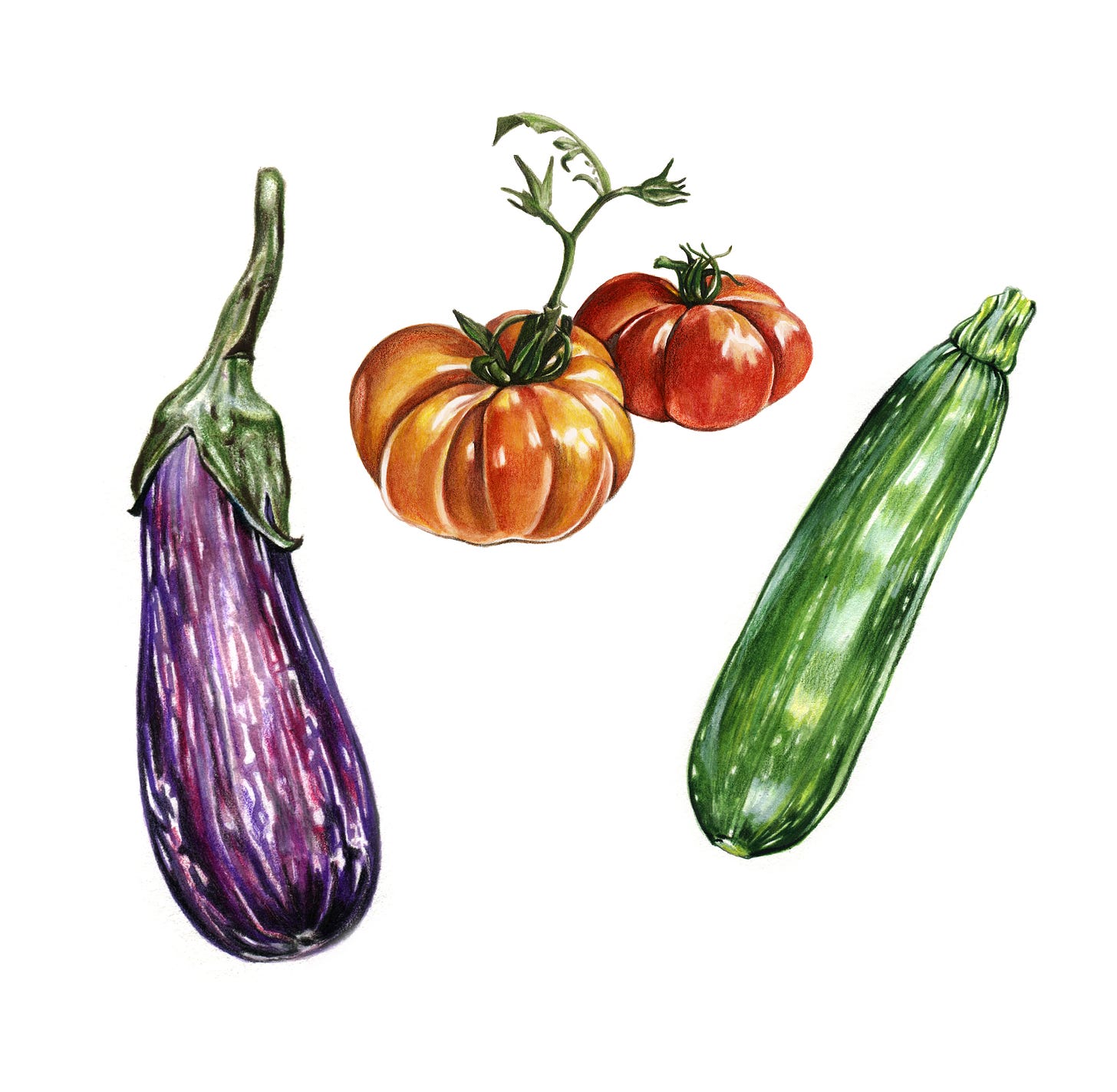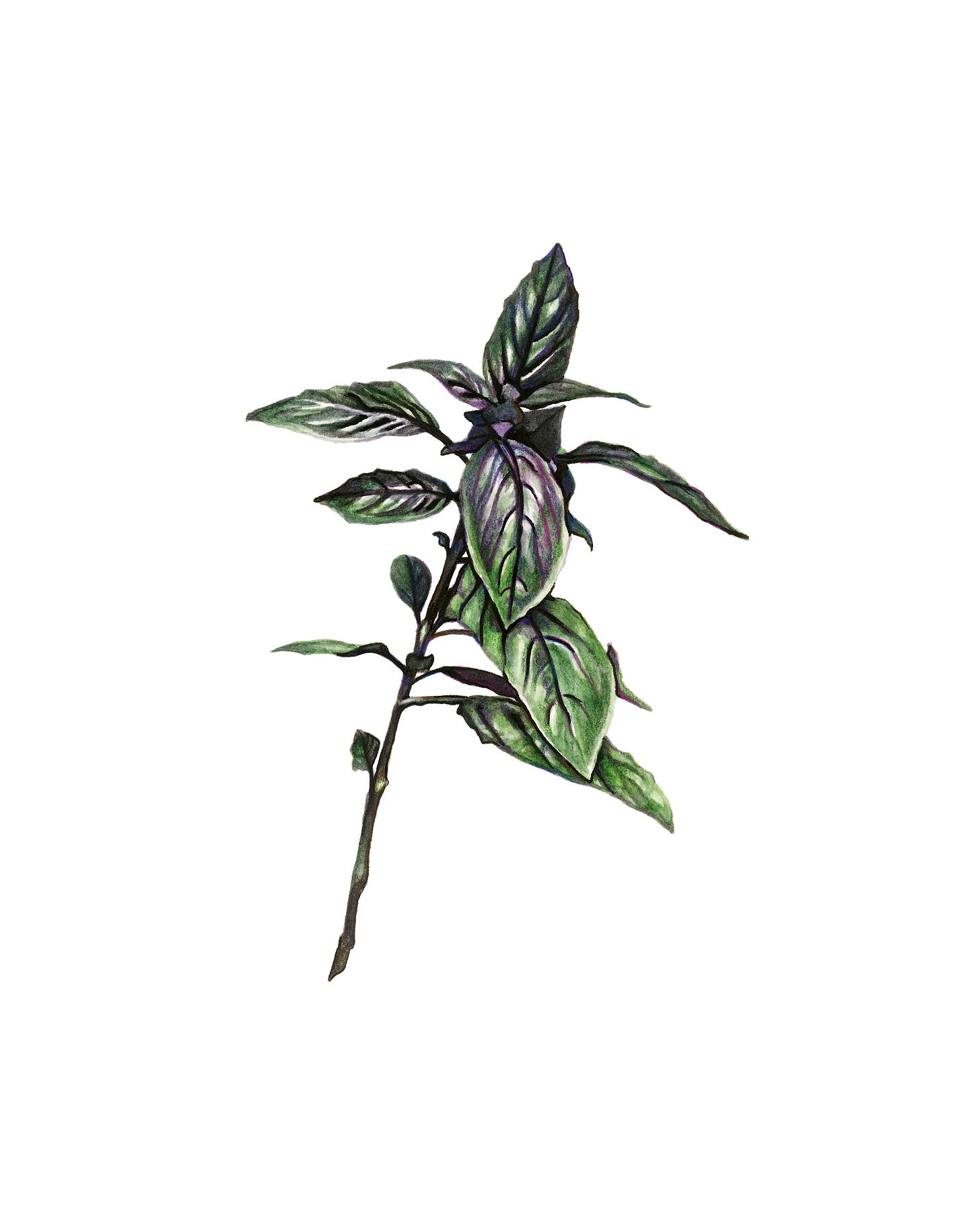Ratatouille is an especially delicious way to make the most of August’s vegetable bounty. We serve the French vegetable stew straight out of the pan as soon as it comes off the stovetop. Ladled into shallow soup bowls, and served along with good bread and sweet cultured butter. The eggplant, zucchini, and tomato stew is highly flavored with basil and garlic and sweet bell peppers and onions, sometimes enhanced with ground coriander or fennel seeds. It is an entrée I’ve been making for nearly as long as I’ve been cooking for family and friends. Leftovers make for delicious lunches, reheated or served at room temperature or chilled. If we are hosting a big family get together or a dinner party, it’s likely that the bowl of ratatouille will become a delicious entrée for vegetarians and a satisfying side for the carnivores at our table, as well.
Several of the babies in our family have enjoyed spoonfuls of ratatouille when they first began to discover the pleasures of eating table food. And, although many then came to reject the dish for a while when they went through those picky phases when age or temperament or who-knows-what decrees that different foods shouldn’t touch one another, or that onions are altogether too slippery, every one of our children has come back to their initial enthusiastic delight in ratatouille. Now we are introducing our youngest grandchildren to the pleasures of a stew made from summers gifts of tomatoes, eggplant, and zucchini.
Ratatouille apparently has a reputation for being especially time consuming or tedious to make, but, maybe because I’ve been making the dish for so long I don’t even have to glance at a recipe. Because I can use the food processor for slicing and dicing, and because the finished product is so comforting, serves so many, and will bring nourishment and pleasure over so many days – I actually look forward to the approximately 90 minutes I will spend making the ratatouille.
The first time I cooked with eggplant – probably in the early 1970s, cookbook and food magazine experts told me I needed to slice the vegetable, salt the slices liberally and leave them under the shower of salt for anywhere from 15 to 30 minutes, and then rinse off the salt, and pat the slices dry before sautéing them in hot olive oil. If you didn’t do this, the experts warned, your eggplant would be bitter.
Advice was mixed regarding peeling. I remember peeling the eggplant the first couple of times I made ratatouille, but once I tried making the stew without peeling the vegetable, I thought the unpeeled veggie tasted just as good as the peeled. After eggplants in a variety of hues began arriving in markets, the visual appeal of a vegetable that could range in color from white to lavender to deep purple to a beautifully mottled exterior called ‘graffiti’ meant that I never peeled my eggplants again.
As for slicing and salting, even though expert advice has varied over the years, with some experts proclaiming that there’s no need to salt because eggplants picked at an appropriate state of ripeness are never bitter, I still slice, salt, let stand, rinse, and pat dry before adding to the stew.
When I can find red, ripe Roma tomatoes at the market – or during an occasionally lucky summer, when I can pick them off the potted plants on our patio – I use those in the ratatouille. But, if fresh summer tomatoes aren’t available, I rely on the canned San Marzano tomatoes that are always on call in my pantry. Both kinds of tomatoes make wonderful ratatouille. When I have fresh basil, I love to add a big handful at the end of cooking. If there’s no fresh basil, I use a teaspoon and a half of dry, or 2 cubes of the frozen basil that you can find in the freezer section at your market, or a healthy squeeze of the basil-and-oil paste that’s available now in tubes, in many supermarket produce departments.
Here's our recipe for ratatouille. Molly and I hope you enjoy the stew during the bounteous month of August and beyond, and that your family and friends love it as much as ours.
-Penny
Ratatouille
Serves 8-10
Ingredients:
1/2 cup olive oil
1 large or 2 medium-size eggplant, sliced, salted, rinsed, patted dry, and cut into large pieces
2 very large onions, sliced thinly (3 cups)
4 cloves garlic, peeled and thinly sliced
4-5 long thin zucchini squash, sliced (3 to 4 cups)
1 large or 2 medium-size red, yellow, or orange bell peppers, cored, seeded and sliced
3 pounds ripe Roma tomatoes, peeled and cut in large dice, or 1 28-ounce can San Marzano tomatoes, squished with your hands and added, along with juice or puree left in can
8 to 12 ounces fresh mushrooms, sliced
2 tsp. Kosher salt
1 tsp. freshly ground black pepper
A big handful of fresh basil leaves, torn, or 1-1/2 to 2 tsp. dried basil (or equivalent amount of frozen cubes or paste from tube)
1/2 tsp. ground coriander or 1/2 tsp. fennel seed (optional)
Preparation:
Rinse eggplant under a stream of cool water, then slice into 1/2-inch slices. Sprinkle a thin layer of Kosher salt on a baking sheet or plate, top with a layer of eggplant slices, then another thin layer of salt, continuing until eggplant is used up and top layer is lightly salted. Let stand for 15 minutes. Use this time to slice and chop remaining vegetables. Accumulate each, separately, on plates or in bowls, and set aside until you’re ready to add to the stewpot.
After 15 minutes, rinse eggplant slices under a stream of cool water, squeezing out excess water from each slice, and lay slices on an absorbent tea towel or a thick layer of paper towels. Press eggplant between towels to dry as thoroughly as possible, and cut into fairly large pieces.
Heat olive oil in a heavy skillet or 4 or 5 quart pot until hot but not smoking. Add sliced onion, and garlic, and sauté over medium high heat for 5 minutes, stirring occasionally.
Add zucchini and eggplant, stir, cover pot, and cook over medium heat for 15 minutes, stirring twice.
Add the sliced bell pepper and all of the tomatoes, along with their juices. Stir well. When the stew is merrily bubbling along, reduce the heat to low, maintaining an occasional bubbling simmer, and, stirring two or three times if you’re nearby, cook for 30-40 minutes.
Now, stir in the sliced mushrooms, and the salt and pepper. Continue cooking for 10 minutes.
Stir in a handful of fresh basil or the alternative basil, and decide whether you want to add coriander or fennel. Both are delicious, but choose only one!
Ladle the stew into shallow bowls and pass excellent French or sourdough bread and your most delicious cultured butter.
*You can fill crepes with ratatouille. Roll them and place in an oiled baking dish, pour melted butter on top and sprinkle with grated parmesan or Gruyere cheese. Bake uncovered for a half hour at 375 degrees F., and pretend you’re sharing a meal at a fancy bistro. (We used to do this in the 1980s when making crepes was “a thing!” I had a cool electric kitchen gadget then which I could use to make a crepe by dipping the gadget into batter, flipping it over, and cooking each thin French pancake for around 90 seconds. It was fun to make the crepes this way, especially since there were often a hungry preschooler or two standing nearby, eagerly waiting to make sure the crepes were meeting our standard of perfection!).
Ratatouille will keep well, stored in a tightly-covered container in your refrigerator for 5 to 7 days. In our experience, it does not freeze well because freezing causes eggplant to change dramatically in flavor.






I always enjoy thoughts from Penny! I like to roast the vegetables and use them to top pizza. I like the crepe idea, too! Thank you for your good ideas!